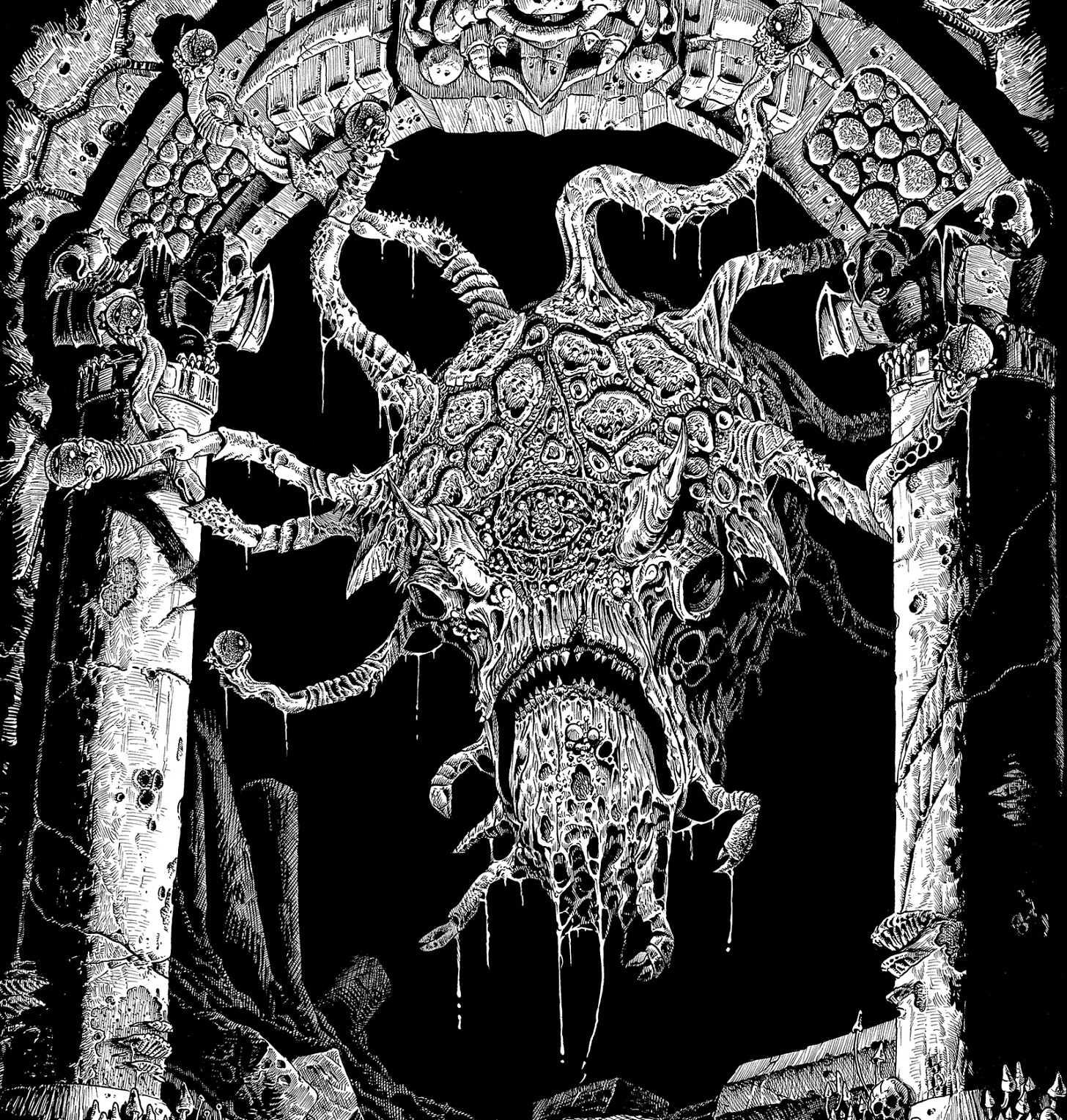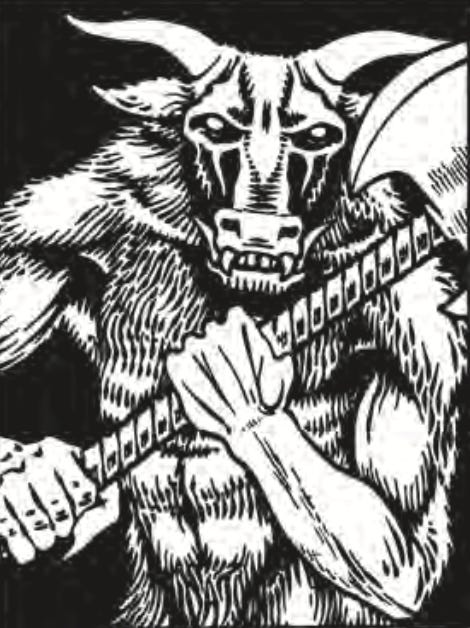What Even *Is* Compatibility
Shadowdark is an OSR game that touts its compatibility with old school dnd, specifically the 1981 b/x version of the game. It is not the only non-retroclone OSR game that makes this claim; in many ways the OSR built on claims of backward compatibility with the old material. Either that or you can do a conversion. But what makes something compatible, and when is a conversion needed?
To explore this claim, I’d like to present an admittedly-simplistic example. A fighter attacks a minotaur. The fighter is 3rd level. For this example, we will be considering a Shadowdark fighter against a Shadowdark minotaur, an OSE (stand in for b/x) fighter against and OSE minotaur, and a Shadowdark fighter against and OSE minotaur.
Shadowdark fighter vs Shadowdark minotaur.
I will assume the 3rd level fighter has +2 in Strength and +1 from weapon mastery, so a +3 total to hit.
The minotaur has an AC of 14.
That means the fighter will have to roll an 11 or higher to hit the minotaur, a 45% chance
OSE fighter vs OSE minotaur
The OSE fighter has +0 to hit
The minotaur has an ascending AC of 13
The fighter needs a 13 to hit the minotaur, a 35% chance
Shadowdark fighter vs OSE minotaur
Shadowdark fighter with a +3 to hit, OSE minotaur with a 13 AC
The fighter needs a 10 to hit, a 50% chance
So is Shadowdark compatible with b/x?
Yes: Of course it’s compatible. If you are using a b/x adventure that has a minotaur in it (like Keep on the Borderlands), simply pull up the Shadowdark stats, and everything will be rebalanced for your Shadowdark game. Yes, the Shadowdark fighter hits a little bit more frequently, but does that small variation really matter that much? The basic point is that the mechanical categories, like HP, AC, to-hit, are the same in both systems, so they are basically compatible. Plus, it’s not like OS adventure designers were really making encounters balanced on a knife’s edge, or anything. If you are playing a ‘rulings over rules’-style game, you have to get used to plenty of on the spot statistical variance in task resolution anyway.
No: I’m sorry, but different numbers are different. If you use the minotaur stats from the module, which is the easiest thing to do, with your Shadowdark fighter, the latter is 15% more likely to hit the former than if you were playing with OSE. And that’s just with the to-hit roll. When one takes into account damage, hit points, saves, and everything else, the variance in gameplay ends up being significant. I mean, we are just talking about to-hit in this example; consider the differences that will result between spellcasters rolling to succeed against their intelligence vs the classic 5 saves in OSE. Across all these differences, the adventure module itself plays quite differently, either easier or harder.
This isn’t just a Shadowdark issue. Knave proclaims the following: “High compatibility with OSR games. If you have a library of OSR bestiaries, adventure and spell books, little or no conversion is needed to use them with Knave.” Yet, when put to the test by someone who really knows what they are doing, these claims fall apart (seriously, read that blog post). Whitehack claims in its second sentence that “it is designed to run just about any material from 1974 onwards with little or no conversion.” Yet, dissatisfaction from the community about the truth of this claim has led to the creator making a somewhat defensive post, writing that if you want 1:1 conversion, “you should use a clone or the original system instead” (he continues, “finally, I'd also like to question the ideal, for any tabletop RPG, that you pick up a module for that game, and then run it without thinking about it.”).
So let’s unpack what we really mean and what we really want when we talk about compatibility and conversion.
Similar mechanical categories: The AC might be 16 or it might be 12, but the important bit is that both games use the same mechanical category, armor class, to gauge chance to hit on a d20 roll. From that point, the specific numbers can be altered and adjusted, but the basic idea of what you are doing when you roll dice is the same in both games. This leaves open the difficulty of converting the 5 classic saving throws, which vary across different creatures and at different levels, to modern OSR systems that tend to rely on universal resolution via ability score. Still, it’s not like we are trying to play the game using a system with wholly different categories, or different dice probabilities (e.g. 3d6 vs d20) to resolve similar tasks.
Toleration for variance: If monster X has an AC 10 in one system, but an AC of 20 in another system, it doesn’t matter that both use AC; those two numbers represent a meaningful statistical difference that make the two systems incompatible. Meanwhile, if monster X has an AC of 13 in one system and an AC of 14 in another, that’s basically compatible. A certain hand-waving attitude is inevitable particularly in the OSR, where the GM might simply decide what a player has to roll based on nothing but their own whim at the moment. Games like ICRPG codify this disposition to a degree, making everything within an an entire room/scene share the same target number.
But in this case, where do we draw the line? How much variance is tolerable?
Approach to running the game: Old school games famously don’t care about encounter balance. The point isn’t whether the minotaur is a little bit harder or easier to hit. It’s about how the PCs can navigate the challenge posed by the minotaur, and that might mean avoiding combat all together with a creature that, no matter its AC, is a difficult foe. Thus, compatibility fundamentally matters less in these kinds of games.
So what do I think?
Well, both things can be true. On the one hand, the details of probability do matter, especially if they extend in one direction or another across different types of rolls. For example, perhaps using Shadowdark but playing a b/x module out of the book makes for characters that have an easier time in combat (it would take more sustained analysis to show this, but let’s say that’s the case). This might affect player behavior, in that combat becomes less of a ‘fail state’ as PCs find that they are more likely to win combat scenarios. That potentially takes away, in a sense, alternative problem solving (negotiation, sneaking, hiring backup, etc). Or, the PCs will level faster or slower with different systems, again affecting the way they approach the module’s encounters.
On the other hand, the systems are similar enough, that if you are playing the game using OSR principles, you will hopefully have more or less a similar experience. Those principles and the way you apply them will matter more than the mechanical details, in other words. In the details, you’ll get a slightly different experience, certainly, but in the aggregate, you’ll get the same emergent story.
B/X has often been described as the ‘lingua franca’ of the OSR. But any lingua fraca creates its own dialects. And that’s a bit of what we have with these ‘modernized,’ universal-resolution systems like Shadowdark or Knave. Ultimately you can certainly play Keep on the Borderlands with those systems. So I think it’s both worth being skeptical of these claims of compatibility, while at the same time realizing that the experience of the participants at the table is not dependent on any particular statistical variance.



Thanks for the shout!
My general take is to assume module author competence; that the author is familiar with the system that they're writing for and that they playtested the module in the system that it was written for.
Even if they didn't playtest, by nature of the module being recommended by other folks, they've done additional playtesting, and often write up thoughts on what works and what doesn't.
When you play the module in a different system with different underlying math, you're now playing something that's less playtested, and so you'll run into more rough edges. For low level modules, I think this comes up *very* often with ghouls.
---
In B/X, a ghoul hits a plate-wearing level 1 front-liner on a 16+ (25% of the time). It attacks 3x per turn, so you expect 0.75 hits per turn for an average of 1.5 damage. First level clerics turn ghouls on an 11-in-2d6, which is 8% of the time, and they can cast turn undead every combat round. Meanwhile, in 1e, Ghouls hit banded+shield turn on a 13+ (40%). Their bite does 1d6 damage instead of 1d3. They're now hitting 1.2x per turn for 3 expected damage a turn, so they're fully doing twice as much damage in 1e as in BX.
Finally, OSE uses different frontage rules; enemies occupy a standard space in a 5' grid, so only two ghouls can attack the front line in a standard hallway. In 1e, there's a whole space required system, so if your GM rules that unarmed humanoids use 2' of frontage then the front line is getting attacked by 5 ghouls, and if it's 3' of frontage then the front lie is getting attacked by 3 ghouls. The net here is that ghouls are putting out somewhere between 3x and 5x more damage per round in 1e than in OSE. Fighting ghouls is going to feel **very different** in 1e than B/X.
An encounter against 5 ghouls might be a tough-ish dangerous fight in B/X, but those same 5 ghouls might be an extremely-likely-tpk in 1e, and so now one of the choices (fight but get taxed hp/spells/etc) has been *removed*. If the ghouls are in some sort of important path in the module (blocking the way to valuable treasure, an important clue, valuable magic item, etc) then now the module will *feel different*.
---
A general note is that every time we play a game in a different system, we're *translating*. Translated books/movies/etc are *not* the same as the original; nuance will always get lost. The more precise and nuanced the dialog is (especially books that "play" with language), the more gets lost. I think this is exactly what happens with translating adventures between systems.
Hello, very interesting reading! Your digression on B/X compatibility turned on my interest as I plan since some time to have a conversion of 3 simple adventures into b/x (or a generic OSR). Would you be open to discuss about the conversion and provide me with an advice? Thanks a lot and ciaoo